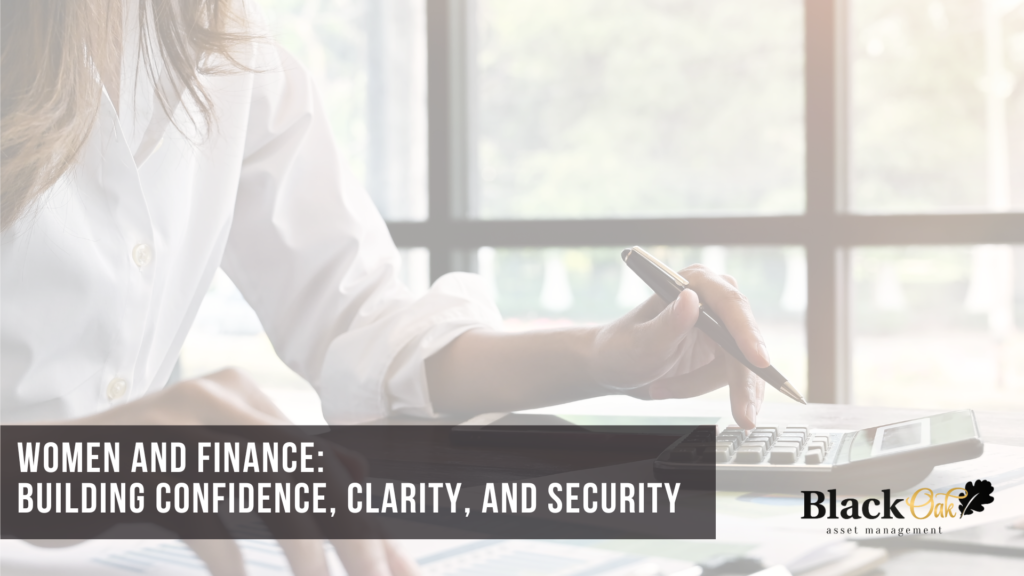
Women and Finance: Building Confidence, Clarity, and Security
Historically, women have traditionally been less likely to invest than men – a trend that has had serious financial repercussions over time. According to a 2021 Vanguard study, the median retirement account balance was $31,291 for women, compared to $45,106 for men – a staggering 44% difference.
However, those numbers are changing for the better. In 2023, Fidelity reported that 60% of women now invest in the stock market (compared with a previous CFA Institute study, which found that only 40% of women were investing). And the retirement savings gap is also closing – according to Fidelity, 68% of women were saving for retirement in 2023 compared to 77% of men.
These advancements are encouraging, suggesting that women are more confident taking control of their financial futures – but there’s still work to be done to ensure women can overcome traditional barriers to financial independence.
What Does Financial Independence Actually Look Like?
A recent Bank of America survey took the pulse of over 3,500 women ages 22 and above regarding what they believe indicates true financial independence:
- 47% said being debt free
- 39% said being able to withstand an unexpected expense
- 34% said not having to ask family members for financial support
Achieving these goals first requires establishing a level of financial knowledge and confidence. For women used to taking a backseat when it comes to financial conversations and decisions, building that trust in themselves can be challenging – but the rewards are extraordinary.
Take Sarah, a 52-year-old widow who found herself in charge of her family’s finances following her husband’s unexpected passing. Sarah handled most of the day-to-day bills but, because she had largely relied on her husband to make bigger financial decisions, she had only a cursory understanding of their investments, savings, and retirement plan. We worked with her to identify her assets, establish a budget, and adjust her retirement plan based on her specific goals – which included donating regularly to her local animal shelter.
Or Maria, whose divorce forced her to do the difficult work of rebuilding – and more importantly, deeply understanding – her financial circumstances. Instead of being overwhelmed, though, Maria found she had a knack for personal finance. She started a successful side business helping other women navigate the nuances of post-divorce finances.
(For more information on navigating divorce or widowhood, you can request a free copy of our book, From Heartbreak to Financial Health: A Guide for Single Women, by clicking here.)
Five Steps to Achieving Financial Independence
Like most major undertakings, achieving financial independence becomes easier and far less daunting when you break it down into a step-by-step process. We recommend the following framework if you’re just starting to take control of your finances:
-
- Perform a financial assessment: Start by figuring out where you stand today. Take stock of your current financial situation, including assets, debts, income, and expenses.
- Establish goals and a budget: Next, figure out what you want your money to help you achieve. Is it buying a home, starting a business, sending your kids to college, retiring comfortably, or some combination? Once you’ve determined your goals, you can define a budget that aligns with your needs and time horizons.
- Manage debt and build savings: There’s a reason being debt-free was the number one answer in Bank of America’s financial independence study. Even if being completely debt-free isn’t a possibility for you right now, prioritize paying off high-interest debt first. As you do, start adding to an emergency savings fund. Traditional wisdom says you should save 3 to 6 months worth of living expenses, but again, don’t let a daunting number stop you from taking any action. Every little bit helps.
- Invest in your future: Don’t be intimidated by investing. Studies show that women outperform men in investment returns. Start small with retirement accounts like 401(k)s and IRAs, and consider diversifying with low-cost index funds.
- Work with a professional: A financial advisor can help you navigate the complexities of saving, investing, and planning for the future, giving you the confidence and peace of mind you need to make the right financial decisions for your goals and your family.
For more in-depth information about how to achieve financial independence, particularly when faced with significant life transitions, download our guide here.
If you’re ready to get started on your journey to financial independence, we’re here to help! Get in touch with the Black Oak team by clicking here.

